Note
Honestly I want something new by 2025. I like MS and taking advantage of no lines at Green but it's getting tiresome.... Then again something Pixar could take over.
That is very true, Mission: Space just isn’t generating the sort of lines you’d expect it to anymore. Although I would like a Pixar based attraction at EPCOT, they are rumoured to be taking over the Magic Eye Theatre anyway and that could lead to over-saturation in the park.
I’d like to see the space theme continue, perhaps maybe build that spacestation building as seen in early EPCOT Center concepts:

Of course, is EPCOT over the grandiose façades of days gone by? Hopefully time and correct decision making will tell!
1 note
·
View note
Text
To be perfectly honest, I’m surprised that it’s still there. Hopefully by 2024 we’ll have Mission: SPACE 2 with better animations and more Gary Sinise
Mission: SPACE
Space was always on the table as a pavilion theme for EPCOT Center, pretty much from day 1, as to be expected from a park featuring the future since humans have had an interest in space colonisation for a long time.
One of the original proposals for the space pavilion was to have a large building with an orbiting space station contained within it

Many different show scenes would have been included within the pavilion. The big sphere in the middle used gravity walls (huge rotating walls). The ride was predictably going to be an omnimover through space as well as an interactive area full of hands-on exhibits. The show would’ve contained a wall of windows gazing out upon earth and the space around it.
Like Wonders of Life however, a lack of sponsor and the overspending on the rest of the park, the plans were shelved and moved to a later phase of attraction openings.
Then Horizons happened, we all know the story of that (Click here if you don’t).
In 1990 Disney released a press release and the plans changed slightly from being an omnimover to being a thrill ride using advanced systems and special effects to give guests an outer-space experience without leaving terra firma.
The positioning of the pavilion had changed as well, no longer was it going to sit where the living seas was sitting, instead it moved between The Land and The Living Seas. However, despite talks with Delta airlines the plans were once again put on hold due to budgetary reasons.
GE declined to renew its sponsorship for Horizons in 1993 just as plans were getting ready to refresh Horizons to make it ready for the 21st century. New Omnimax films, sets, projection systems, animatronics and score were all proposed. The lack of sponsor made Michael Eisner decline the update as it would’ve been too expensive.
Disney then thought about merging two projects, the space pavilion and Horizon’s refresh as the Horizon’s building was thought to be suitable for a complete gutting and refurbish of the pavilion. In this version, guests would be suspended from the overhead ride rails in vehicles that closely mimicked NASA’s Manned Manoeuvring Unit (Space Jetpack) and be sent on a Spacewalk.

Concept art of this version, looks pretty nice. Utilising the full height of the Horizons building (Embedded)
The problem with this ride wasn’t budget this time (although it was a factor), instead the problem was capacity. An attraction like this would be very popular but due to the way in which it worked, it would always be at full capacity. The project was shelved. The horizons building was not suitable for this type of attraction.
In 1999 Compaq (the manufacturers of my first laptop) entered talks with Disney about a possible space pavilion, this time going back to the second iteration of Journey’s through space.
9th January 1999 Horizons closed, and over a year later on 20th April 2000 a ceremony was held to announce the demolition and future plans of Horizons as it became, Mission: SPACE.
Of note, in this announcement the statement was made that the Horizons building was not big enough to hold the new attraction. Of course just by looking at maps you can tell that this simply isn’t true. The truth is probably more likely to be the structure of the building as it wasn’t designed to hold four 5G centrifuges. A lot of work would’ve had to have gone into re-designing the ground floor of Horizons and most of the pavilion then would’ve been wasted, empty space that would still require maintenance.
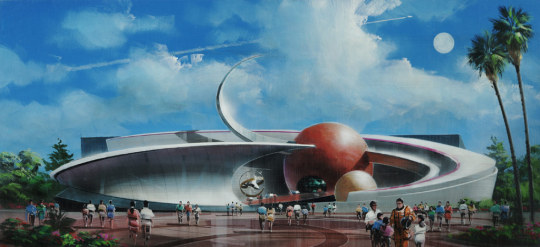
Here is the proposed concept art for Mission: SPACE, the final version was very close to this with a few minor changes but damn, does it look good (Embedded)

The finished version, taken from roughly the same angle (by myself, oh yes). Much has stayed the same allbeit with slightly different angles on some of the features such as the spire and the juts. Some vegetation was added to spruce up the place.
The Space pavilion finally opened 15th August 2003, 25 years after the original plans were introduced.
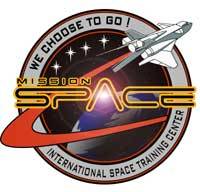
Mission: SPACE Logo
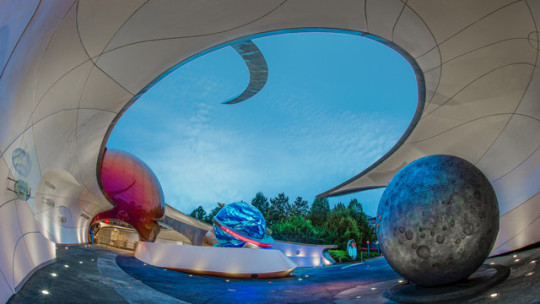
The entrance features a map of the moon with all of the landing sites shown on its surface, guests enter through the underside of Mars
The preshow is laid out initially as a museum of space flight, much like that of the Living Seas. Since Mission: SPACE takes place in the space age year of 2036 (Exactly 75 years after Yuri Gagarin became the first human to enter space) some of the historical artefacts may be fictional, only time will tell on that one.
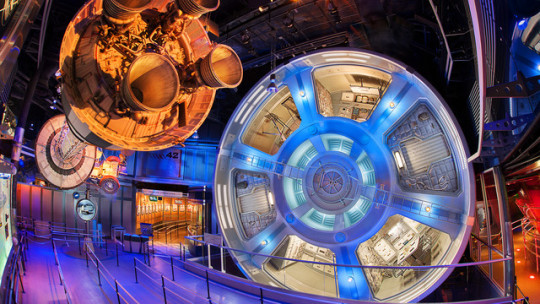
The Horizons logo can be seen in the middle of the big gravity wheel (that rotates) a close-up can be seen here
From here, guests go into a briefing room for a quick presentation with Gary Sinise (Apollo 13, CSI: NY and the Mediocre Mission to Mars, a film about the first manned mission to Mars which was realeased six days before it was announced Horizons would be demolished). Here guests would be introduced to their X-2 Deep Space Shuttle.

Guests then entered 1 of 4 ‘Ready rooms’ for further breifing and those all important safety spiels (of which there were a few variations), guests would also be assigned a number here which corresponds to a job inside the space craft. Each ready room then released guests row-by-row into the chamber corridor.
There are 4 centrifuges, 10 cabins per centrifuge and four seats in each cabin giving the ride a maximum capacity of 120 guests. Guests then enter the centrifuge chamber and sit in their assigned seat.

The centrifuge cabin is similar in size to this

The interior is rather cosy…
After ride completion, all paths lead out to the exit and from the rear two centrifuges, it is a bloody long walk I can tell you.
Guests can then participate in mission control games (which riders who aren’t up to the challenge of Mission: space can skip right ahead to).
All cast members working in Mission: SPACE are trained to deal with what are known as Code V’s or protein spills. I.E. Someone is throwing their guts up thanks to motion sickness. The exit hallways have comfort closets with sinks, cleaning agents and running water. Temperature control is also really important when keeping guests from being sick, the AC is turned way down low and the X-2 simulators blow cold air into guests faces. (Source: A great article written by a cast member)
youtube
Why is this ride disliked?
Good question. The main reason is actually to do with what it replaced, Horizons. One of, if not the most grandest ride Disney have ever done. It’s sheer scale and attention to detail, not to mention some innovative features for 1983 was what made Horizons special. Then it is replaced by a bare-bones (admittedly it is an attraction built to be a test facility) off the shelf ride with little in the way of themeing. Although it does have Gary Sinise.
It just feels a bit, meh in comparison to its predecessor.
However I will say that I first rode this before I found the internet and became a full on EPCOT connoisseur and as an average guest I rather enjoyed it but even then I would’ve liked a bit more themeing such as that found over at Body Wars as that too is supposed to be a facility and had much better (not to mention futuristic) theming.

Media Hype?
Anyone who knows anything about this ride will know all about this. Several people (majority of which are middle aged+) have had to be taken to hospital after riding the simulator due to chest pains and nausea.
Mission: Space has also claimed two lives, a 4 year-old boy with an un-diagnosed heart condition and a 49 year-old woman who had a stroke thanks in part to her abnormally high blood pressure.
Although warning signs were placed everywhere warning guests of the dangers and risks, it still didn’t help those who didn’t know they had these problems or those un-familiar with the effects of higher than usual gravity on the body (as a student of Engineering, it ain’t pretty) the media still put the blame on Disney for not doing enough for guests.

What happened next?
19th May 2006 introduced Green Team and Orange Team. Green Team is the Less Intense training where the centrifuge does not spin so the effect of enhanced gravity does not exist. Pitch and pivoting is still done by the cabs.
Orange team is the original version, however, some say that the centrifuges have been toned down a bit since opening day. Reviews of the ride from Astronauts have praised the attraction for how lifelike it is, even more-so than the recently opened Atlantis flight simulator over at Kennedy Space Center.
In conclusion…
Mission: Space, not nearly as great or as awe-inspiring as Horizons. However just like Horizons, it is a product of its time and tries to accurately reflect where we see ourselves in 20 years time. Although it isn’t half of what Horizons is, at least it keeps the premise of looking to the future alive and well and develops on one of the most beloved scenes in Horizons, the space scene.
Next time we’re looking at:
Test Track and Test Track 2.0
See you then!
17 notes
·
View notes
Text
Test Track
Test Track, a look inside the world of car testing.
On 2nd January 1996, World of Motion closed its doors for the very last time after General Motors asked imagineers to design a new ride that focussed solely on cars and the automotive industry. World of Motion was prepared for what should’ve been a 16 month long renovation. Guests were told that when Test Track opened, they would be put through a series of car tests.
The Test Track stemmed from one of the original plans for the transportation pavilion which was under development since 1976. Imagineers visited the GM testing facility in Milford, Michigan where they saw prototype cars being tested on the proving grounds, from this tour of the grounds the original concept for the pavilion was developed. In 1978 a plan for the pavilion had a ride through exhibition (much like the queue to Test Track) followed by a track on the exterior of the building

The circular design of one of the original concept buildings
But the pavilion was going to hold a second attraction where guests were able to test concept vehicles of tomorrow (somewhat like Test Track 2.0).
Plans for this GM Proving Grounds at EPCOT Center were dropped in 1979 in favour of World of Motion which fit the theme of original EPCOT Center almost perfectly.
In 1994 the project was revived after GM requested a new ride as part of their new sponsorship deal, and idea that Disney management was happy to pursue as well.
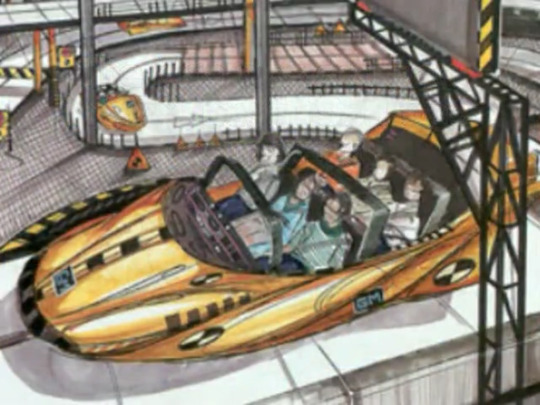
One of the original designs for the Test Car on Test Track, this was abandoned as Imagineers felt that the attraction would date itself if it was set in the future and it was felt that it would be better if the experience was as close to the real thing as possible.

The ride began with a three storey hill climb, almost to the ceiling of the show building, next guests would’ve found their way travelling through several environmental chambers designed to test how well the car will cope in 4.4°C (40°F) and 48.9°C (120°F).
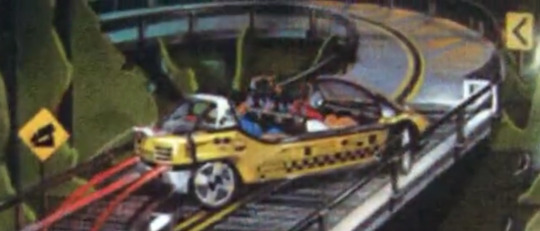
Guests would then have done a handling test to see how well the cars perform (from concept images it looked like under/oversteer would’ve been simulated as well, which would’ve been amazing)
Outside, guests were sent around half a mile of track at 95 mph, the top speed quickly changed to the lower speed of 65 mph because that was Florida’s speed limit (should’ve built it in Germany, the Autobahn has no speed limit) this also reduced the angle of the bank on the track making the ride more comfortable for guests should the ride have to break down (my research has shown that 47° is the comfort threshold, guests can experience breakdowns on banks greater than 47° but it’s not a pretty site especially in those shorts).
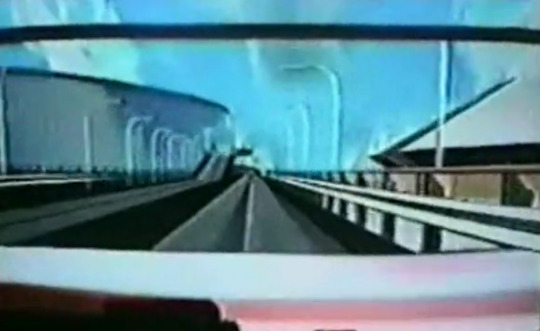
3D rendering of the outside test loop (note horizons passing on the right of the image)
When renovations started, the plans were to gut the entire pavilion, not only to get a fresh start but also contribute to the industrial theme of the attraction. The gap in the front of the building where omnimovers looked out across the path was closed and in it’s place a track running around the outside the front of the building (as proposed in the early 1978 plans) was erected.
The inside of the building was also totally changed as well, the ground level of World of Motion now became the queue, the preshow and the dispatch area for Test Track. The first floor was completely emptied and replaced with a track and a few set-pieces designed to add some environmental factors to the track (although it was clear that they were fake). The centre column of the building used to hold the 6 storey city of the future, this was removed to make way for the first test, the hill climb which took guests up to the newly formed second level.
There were 31 ride vehicles made for Test Track, each with 3 computers, 6 breaking systems and an electric motor capable of producing 250 Horsepower. The front and rear wheels are both able to turn independently to give very precise turning. The cars were attached to a track system running underneath the road to provide power to the motor and the braking system, keeping the car on this track system are 18 wheels hidden underneath the road to try and eliminate as many variables as possible. The track length was 1 mile long.
Spring 1997 was the original projected date of opening. This date came and went rather quickly. Although the attraction was completed, problems started occurring almost immediately. Computer issues, 1997 computers simply were not powerful enough meaning that the maximum amount of vehicles that the track could run was 5, any more and the control software would just crash so the ride control software had to be rewritten to be more efficient and the control computer would need to be re-built to cope with the added loads.
But computers were not the only problem, as you may be aware pushing cars to their limits can be quite taxing on certain parts of the car, specifically the tyres. They just weren't strong enough to last an entire day so good year had to go to the drawing board and design a slick tyre capable of withstanding 70 psi.
This pushed the opening date to ‘Opening Soon’ to give the imagineers more time. However at the tail end of 1998 guests were able to see the entrance for the very first time. Testing was completed and GM executives got to ride Test Track in December 1998. Guest previews of the ride ran on the 19th December 1998.
A dedication ceremony for Test Track was held on 17th March 1999, 3 years, two months and 15 days after the closing of World of Motion.

Original Test Track Logo
The queue of the ride showed off scenes of car part torture tests, including the perpetual smashing of a windscreen. The queue was essentially split into two, standby line seeing a lot of display boards and tests. Single riders and fastpass would pass through an anechoic chamber designed for testing radio receivers. Here guests could hear the attractions signature theme composed mainly of car noises, the ‘Test Track’ medley was composed by George Wilkins and can be listened to in all it’s FLAC glory here
At the end of the queue guests would come to a preshow area where the hosts (Bill McKim and Accomplice) where they would piece together the test schedule (2, 5 and 7). From the preshow area, guests proceeded down the queue lines merging standby and fastpass. Guests would then be assigned a place to sit.
youtube
The test began with a seatbelt check, once clicked in the seatbelts could not be removed until the ride system allowed for them to be taken off.
Tests ran in this order:
Hill Climb - Test the engines performance on a hill, AKA a disguise for getting riders to the show area
Suspension - Different road surfaces were set up to show how the cars suspension worked
ABS - Shows the advantages of Anti-lock breaking systems
Environments - Attempted to show how the body of the car reacted to differing environmental factors (but really just an excuse to give guests hypothermia). The hot chamber got up to 48.9°C (120°F) and the cold chamber brought the temperature down to 4.4°C (40°F), corrosive robots sprayed the car with rust promoters, but it was just water really
Hill climb - Shows off how the car handles depending on different speeds and sharpness of corners. At the top the car nearly gets rammed off the road by a truck (Ever wonder what ‘Track Course B’ was? It was an alternative track that lead into car storage, spare vehicles were kept in here as well)
Crash barrier - Guests are positioned in front of a test barrier and launched at full speed towards it (airbags turned off), here the photo is taken and the door opens at the last second for the car to then complete its lap around the outside track at 65 mph
youtube
Guests would then disembark and proceed to a photo pickup point and the post show; The Assembly Experience. This was a walkthrough post show to give guests a feeling of what it is like on the manufacturing line.
What happened next?
Initially only a few narration changes were made to the attraction, most notably in the corrosion room where Bill’s accomplice would answer back and also at the point where the car is almost run off the road, a piece of dialogue was lost there as well as a small pyrotechnic.
The first barrier test used to move, showing guests what the crumple zones on the car do in a crash. It was an impressive piece as it was able to reset back into a healthy looking car ready for the next vehicle to come by, it became a static display eventually probably due to running costs.
Eventually on 6th January 2012 Disney Parks announced their plans to renovate test track by Autumn 2012 and the original Test Track closed on 15th April 2012
That’s all for Test Track for now, this post was going to contain test track 2.0 as well but it’s pretty long already.
So join me next time for:
Test Track 2.0
See you then!
18 notes
·
View notes
Link
May I introduce to you the new EPCOT forum. The place to discuss anything and everything to do with EPCOT.
I’ll see you on there
1 note
·
View note
Text
Mission: SPACE
Space was always on the table as a pavilion theme for EPCOT Center, pretty much from day 1, as to be expected from a park featuring the future since humans have had an interest in space colonisation for a long time.
One of the original proposals for the space pavilion was to have a large building with an orbiting space station contained within it

Many different show scenes would have been included within the pavilion. The big sphere in the middle used gravity walls (huge rotating walls). The ride was predictably going to be an omnimover through space as well as an interactive area full of hands-on exhibits. The show would’ve contained a wall of windows gazing out upon earth and the space around it.
Like Wonders of Life however, a lack of sponsor and the overspending on the rest of the park, the plans were shelved and moved to a later phase of attraction openings.
Then Horizons happened, we all know the story of that (Click here if you don’t).
In 1990 Disney released a press release and the plans changed slightly from being an omnimover to being a thrill ride using advanced systems and special effects to give guests an outer-space experience without leaving terra firma.
The positioning of the pavilion had changed as well, no longer was it going to sit where the living seas was sitting, instead it moved between The Land and The Living Seas. However, despite talks with Delta airlines the plans were once again put on hold due to budgetary reasons.
GE declined to renew its sponsorship for Horizons in 1993 just as plans were getting ready to refresh Horizons to make it ready for the 21st century. New Omnimax films, sets, projection systems, animatronics and score were all proposed. The lack of sponsor made Michael Eisner decline the update as it would’ve been too expensive.
Disney then thought about merging two projects, the space pavilion and Horizon’s refresh as the Horizon’s building was thought to be suitable for a complete gutting and refurbish of the pavilion. In this version, guests would be suspended from the overhead ride rails in vehicles that closely mimicked NASA’s Manned Manoeuvring Unit (Space Jetpack) and be sent on a Spacewalk.

Concept art of this version, looks pretty nice. Utilising the full height of the Horizons building (Embedded)
The problem with this ride wasn’t budget this time (although it was a factor), instead the problem was capacity. An attraction like this would be very popular but due to the way in which it worked, it would always be at full capacity. The project was shelved. The horizons building was not suitable for this type of attraction.
In 1999 Compaq (the manufacturers of my first laptop) entered talks with Disney about a possible space pavilion, this time going back to the second iteration of Journey’s through space.
9th January 1999 Horizons closed, and over a year later on 20th April 2000 a ceremony was held to announce the demolition and future plans of Horizons as it became, Mission: SPACE.
Of note, in this announcement the statement was made that the Horizons building was not big enough to hold the new attraction. Of course just by looking at maps you can tell that this simply isn’t true. The truth is probably more likely to be the structure of the building as it wasn’t designed to hold four 5G centrifuges. A lot of work would’ve had to have gone into re-designing the ground floor of Horizons and most of the pavilion then would’ve been wasted, empty space that would still require maintenance.

Here is the proposed concept art for Mission: SPACE, the final version was very close to this with a few minor changes but damn, does it look good (Embedded)

The finished version, taken from roughly the same angle (by myself, oh yes). Much has stayed the same allbeit with slightly different angles on some of the features such as the spire and the juts. Some vegetation was added to spruce up the place.
The Space pavilion finally opened 15th August 2003, 25 years after the original plans were introduced.

Mission: SPACE Logo

The entrance features a map of the moon with all of the landing sites shown on its surface, guests enter through the underside of Mars
The preshow is laid out initially as a museum of space flight, much like that of the Living Seas. Since Mission: SPACE takes place in the space age year of 2036 (Exactly 75 years after Yuri Gagarin became the first human to enter space) some of the historical artefacts may be fictional, only time will tell on that one.

The Horizons logo can be seen in the middle of the big gravity wheel (that rotates) a close-up can be seen here
From here, guests go into a briefing room for a quick presentation with Gary Sinise (Apollo 13, CSI: NY and the Mediocre Mission to Mars, a film about the first manned mission to Mars which was realeased six days before it was announced Horizons would be demolished). Here guests would be introduced to their X-2 Deep Space Shuttle.

Guests then entered 1 of 4 ‘Ready rooms’ for further breifing and those all important safety spiels (of which there were a few variations), guests would also be assigned a number here which corresponds to a job inside the space craft. Each ready room then released guests row-by-row into the chamber corridor.
There are 4 centrifuges, 10 cabins per centrifuge and four seats in each cabin giving the ride a maximum capacity of 120 guests. Guests then enter the centrifuge chamber and sit in their assigned seat.

The centrifuge cabin is similar in size to this

The interior is rather cosy...
After ride completion, all paths lead out to the exit and from the rear two centrifuges, it is a bloody long walk I can tell you.
Guests can then participate in mission control games (which riders who aren’t up to the challenge of Mission: space can skip right ahead to).
All cast members working in Mission: SPACE are trained to deal with what are known as Code V’s or protein spills. I.E. Someone is throwing their guts up thanks to motion sickness. The exit hallways have comfort closets with sinks, cleaning agents and running water. Temperature control is also really important when keeping guests from being sick, the AC is turned way down low and the X-2 simulators blow cold air into guests faces. (Source: A great article written by a cast member)
youtube
Why is this ride disliked?
Good question. The main reason is actually to do with what it replaced, Horizons. One of, if not the most grandest ride Disney have ever done. It’s sheer scale and attention to detail, not to mention some innovative features for 1983 was what made Horizons special. Then it is replaced by a bare-bones (admittedly it is an attraction built to be a test facility) off the shelf ride with little in the way of themeing. Although it does have Gary Sinise.
It just feels a bit, meh in comparison to its predecessor.
However I will say that I first rode this before I found the internet and became a full on EPCOT connoisseur and as an average guest I rather enjoyed it but even then I would’ve liked a bit more themeing such as that found over at Body Wars as that too is supposed to be a facility and had much better (not to mention futuristic) theming.

Media Hype?
Anyone who knows anything about this ride will know all about this. Several people (majority of which are middle aged+) have had to be taken to hospital after riding the simulator due to chest pains and nausea.
Mission: Space has also claimed two lives, a 4 year-old boy with an un-diagnosed heart condition and a 49 year-old woman who had a stroke thanks in part to her abnormally high blood pressure.
Although warning signs were placed everywhere warning guests of the dangers and risks, it still didn’t help those who didn’t know they had these problems or those un-familiar with the effects of higher than usual gravity on the body (as a student of Engineering, it ain’t pretty) the media still put the blame on Disney for not doing enough for guests.

What happened next?
19th May 2006 introduced Green Team and Orange Team. Green Team is the Less Intense training where the centrifuge does not spin so the effect of enhanced gravity does not exist. Pitch and pivoting is still done by the cabs.
Orange team is the original version, however, some say that the centrifuges have been toned down a bit since opening day. Reviews of the ride from Astronauts have praised the attraction for how lifelike it is, even more-so than the recently opened Atlantis flight simulator over at Kennedy Space Center.
In conclusion...
Mission: Space, not nearly as great or as awe-inspiring as Horizons. However just like Horizons, it is a product of its time and tries to accurately reflect where we see ourselves in 20 years time. Although it isn’t half of what Horizons is, at least it keeps the premise of looking to the future alive and well and develops on one of the most beloved scenes in Horizons, the space scene.
Next time we’re looking at:
Test Track and Test Track 2.0
See you then!
17 notes
·
View notes
Text
Wonders of Life
The pavilion has roots back to the original concept of EPCOT Center however due to a lack of sponsor to cover the cost for such a pavilion the concept was put on the back burner for a while.
Finally, MetLife signed on as sponsor of the pavilion. Disney announced plans for the Wonders of Life in 1987 with ground breaking in February of 1988 and the pavilion opened on 19th October 1989.
The original concept for the pavilion was known as ‘Life and Health’, the plans for the pavilion were finalised in 1978. The concept showed off a circular building with outposts holding rides and attractions
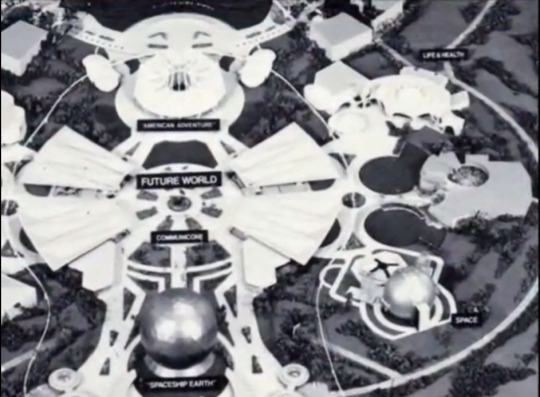
Plans called to have a giant waterfall right inside the entrance. This early plan also outlined a circus like theme (often referred to as the ‘Midway of Life’) with the attractions jutting out from the hub. The original roster of attractions were:
Journey Within - a dark ride that would let guests explore the human body from within
Good Health Habits - “A three-part animatronic fable”, the original theatre design was to have a rotational theatre, much like the one seen in the Carousel of Progress
Head Trip - an animatronic show featuring emotion, intellect and nervous system. “Humorously explaining the data handling and communication capabilities in all of us”
Tooth Follies - A musical revue centred around your gob. Much like Kitchen Kabaret.
Sensory Maze - Presumably similar to the sensory funhouse
The Joy of Life - Edutainment film showing “good health is based off of your own personal behaviours”
The original concept was huge and had a decently sized line up of attractions to match. No wonder finding a sponsor was so difficult.

Concept drawing from c.1987 (Embedded)
To ensure that the pavilion was as scientifically accurate as possible, Marty Sklar the then current president of Imagineering told the Imagineer’s in house publication (WD Eye) that a lot of testing the waters had occured. A conference called ‘Good Health in America’ happened in 1976/77 which established an advisory board. The board proved helpful to Disney, Sklar later stated that over the 14 year planning for the pavilion, the understanding of the human body was constantly changing. This should’ve been taken as an omen of things to come.
Life and Health was finally cut down to just one central theme, “Your role in managing your own body and your own health.”
One of the most major changes done to the pavilion was the changes made to Journey Within. The attraction had moved with the times. Over the course of EPCOT Center’s existence a new ride had popped up in Disneyland. A simulator ride based off of the Star Wars franchise. This became known as “Body Wars”, more on that later.

Construction went on its merry way, ready for the pavilion to open 19th October 1989.
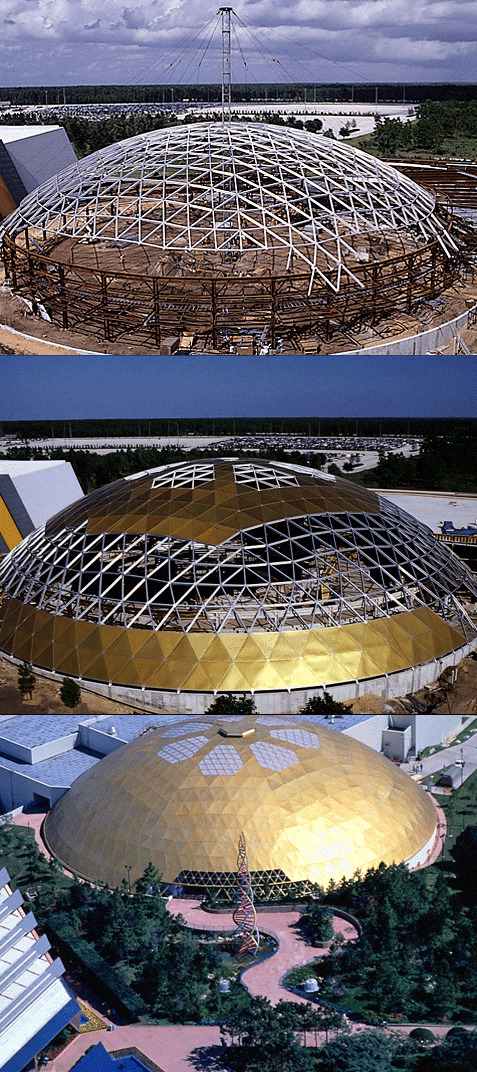
The geodesic dome over the circus portion of the pavilion stood a massive 23 m (75 ft) into the air. A structure was erected outside, standing 23.2 m (76 ft) into the air, it was a stylised rendition of the Double Helical DNA strand, this was entirely made out of steel and carbon.

The DNA structure going up, still un-painted other than it’s waterproof coating (Embedded)
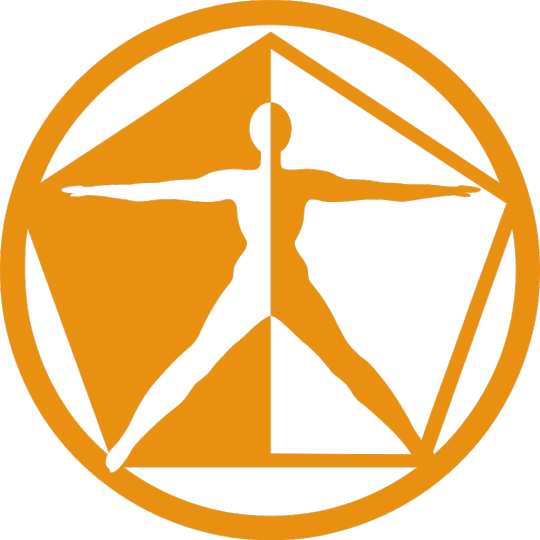
The logo for the pavilion

(Embedded)
The original entrance was a grand affair with a large golden arch and the pavilion name overhead in that oh-so-recognisable EPCOT Center font.
Inside was equally as grand, the design aimed to be both futuristic yet a bit nostalgic

(Embedded)
Attractions
Body Wars
As discussed earlier this was originally a dark ride, however the big push to simulator was because the level of detail needed for the huge set pieces and then requiring them to move was almost impossible.
Leonard Nimoy was brought in as the film’s director. 70mm film was used in the cameras and contrary to popular belief, the whole film was not done in CGI but rather Industrial Light and Magic mixed CGI and stop motion effects and models to get a really grand scale on the whole film.

Body Wars concept art (Embedded)
The queue for the attraction placed guests in the role of “observation team members” as they were being prepared for an observational trip into the human body. Guests passed under a “level 1 and level 2 dermatopic purification screen” to cleanse themselves of any bacteria that could infect the host. The queue was designed to be as close to a working facility as possible, with cast members in full uniform as well as constant overhead announcements being made. The facility was called “MET: Minaturized Exploration Technologies” perhaps in reference to the then sponsors MET LIFE
Separate holding areas are placed throughout the queue to provide guests with more information about what is really going on inside their body’s and what the trip will hope to show them.
Guests are told that they will board their ship, an LGS 2050 probe registration Bravo 229. It weighs 26 tons (the same weight as the simulators). Once miniaturised it will have a mass less than that of a drop of water.
Guests are then shrunk down and enter the body to go on their ‘exploration trip’ to meet up with Dr. Cynthia Lair, who is observing a splinter.

Of course, things go arigh and Dr. Cynthia Lair has to be chased through the human body.
youtube
This video is from 2006, after some minor changes were made. This will be covered below.
Four vehicles are referenced in body wars:
Bay 1: "Zulu 714"
Bay 2: "Bravo 229"
Bay 3: "Sierra 657" and "Foxtrot 817"
Bay 4: "Charlie 218"
Cranium Command

This attraction is an animatronic show demonstrating the importance of the human brain. Now, this show was largely lost on both foreigners like myself and the target demographic as it featured characters, performers and voices from Saturday Night Live, a sketch show on American broadcaster NBC which dated the show very quickly.
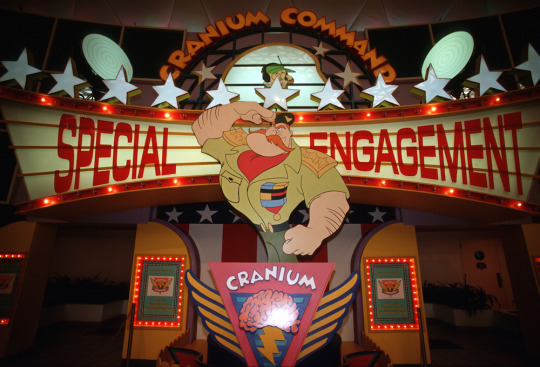
The pre-show was animated and featured Corey Burton as General Knowledge (I know) briefing the Cranium Commandos on their mission to pilot a human brain. The General’s speech is interrupted by the arrival of Buzzy, who is subsequently mocked by Knowledge and then put in charge of the most unstable model, a 12 year-old boy.
On a side note: The pre-show was my favourite bit of the attraction, simply because it was funny. General Knowledge was a well written character, employing both visual and written humour.
The main show takes place in a theatre designed to look like the inside of a human head.

Buzzy, now in control of the boy, has to navigate his way through a ‘typical’ adolescent male’s day. Of course it all starts to go wrong very quickly and snowballs into a food fight, major body functions start working overtime and General Knowledge has to step in.
The show was written by Jenny Trip. The pre-show was animated by Pete Docter who later became a director at Pixar and directed the film Inside Out which was inspired by Cranium Command
youtube
The Making of Me

Directed by Glenn Gordon Caron and starring Martin Short, the film tells guests about how they were born by explaining to the audience how Martin Short’s parents met each other over the course of their lives.
It explains the fertilisation between sperm and egg cells in an animated segment as well as re-used footage of a foetus developing in the Womb, captured by Lennart Nilsson and previously used in ‘NOVA’s’ Miracle of life special.
youtube
The show caused some controversy as it was a departure from the typical Disney attraction (then again, so was pretty much all of EPCOT). An advisory sign was placed near the entrance of the theatre to educate families on whether or not the show was suitable for their family.
It is an amazing film and very well done, it is on the light side which for a film about birth is very surprising and refreshing.
Side Shows
Frontiers of Medicine
Stories about medicine and the human brain, presented on television dotted around the room

Photo Taken in 2010, but more on that later (Embedded)
Coach’s Corner
Guests can try their hand at various bat and club based sports whilst feedback is given to them by professional players
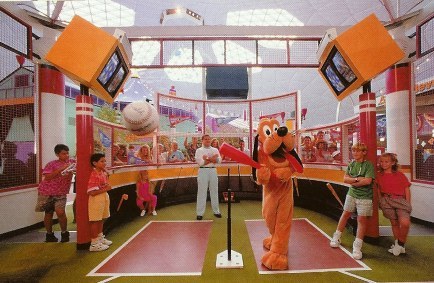
To be honest, Pluto is probably better than I am at many sports (Embedded)
Goofy About Health
A multiscreen show using recycled clips from various Goofy Cartoons
youtube
Fitness Fairgrounds
Guests athletic abilities were put to the test in a series of rigorous activities
Sensory Funhouse
Playground which required guests to use all of their senses. They were even kind enough to include what is known as an Ames room, watching the small children look at that one was hilarious

(Embedded)
Wonder Cycles
Fondly remembered by many guests. They were stationary bicycles with a television attached. A video played on the screens and the faster the guest cycled, the faster the videos played. The cycles had three tours:
100th Anniversary Rose Parade in Pasadena, California
Disneyland California
Microworld Bigtown, U.S.A.
Guests could see the guests of Disneyland look bewildered at the camera and quickly dive out of the way.

(Embedded)
Anacomical Players
Live show based around improv on health and nutrition... exactly as it sounds
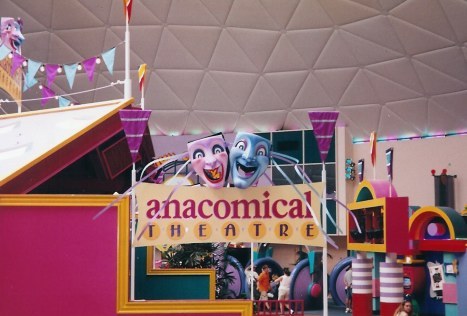
(Embedded)
Shops
Well and Goods Limited
A gift shop for the pavilion
Food
Pure & Simple
Sold healthy snacks
What Happened Next?
That is the golden question, what did happen next? The pavilion was initially very popular with guests, however, changes happened almost immediately.
30-seconds was edited out of the Body Wars film due to guest complaints of the moving motion being to intense in some places.
The giant archway was removed in favour of a smaller sign

Anacomical players was cut in 2000 due to dwindling numbers, shortly followed by Pure and Simple and Well and Goods Limited.
In 2004 the pavilion became seasonal until 1st January 2007 when it closed its doors for the very last time.
Over the next few years, slowly and quietly, parts were removed, starting with the exterior

(Embedded)
Murals on the inside were slowly pulled down (although the body wars sign was left up for a long time, as was the making of me and cranium command signs)

(Embedded)
Finally, in 2014, the four simulators for Body Wars were dismantled and removed from the building. The queue is largely still intact sans electronic and lighting equipment. Currently the Body Wars building is just storage for Food & Wine and Flower & Garden festivals.
The picture above of Frontiers of Medicine was taken in 2010, showing it still intact with all the lighting working. This is the saddest thing about this pavilion, although it isn’t open for it’s original intended purpose anymore Disney are refusing to let it die. The internal phone system still has all the original attraction names listed to this day. It is the only future world pavilion to not be replaced by anything and just forced to live out the rest of it’s life as a shell of what it used to be.
The first contributing factor in this decision to make the Wonders of Life into the Festival Center was the drop of sponsorship from MetLife which ended in 2001. The second is that it was never updated or ‘plussed’, the only changes made were to remove things which meant that it dated so quickly as it opened on the cusp of the 90′s during one of Disney’s weird phases. Slowly, over the years it fell into obsolescence with outdated information and a very outdated design.
The likelihood of this pavilion opening again as the Wonders of Life is currently very remote, although most of the pavilion is still intact including the horrifying MetLife board rooms (Photos of Which can be found here, however the carousel one is not included in this photoset, you can see it in Martin’s Ultimate Tribute).
What’s in the future for the Wonders of Life? Well, truth be told, I think that it is too useful to Disney during the festivals to give it up as that space, it is also hired out as a public space for events if need be. I do however see the entire inside being ripped out and remodelled to be less like a circus and better suited to being an exhibition space. Cranium command is probably going to be completely removed to make way for a lecture room, there isn’t really much you can do with Body Wars due to its design. The making of me theatre will probably stay however it will get a fresh coat of paint.
I don’t usually speculate on these sorts of things, but unfortunately the Wonders of Life has been closed for 8, nearly 9 years now. Cranium Command must be almost irreparable now due to decay.
Thank you for sitting through all of that, next time we take a look at a rather controversial attraction,
Mission: SPACE
See you then
youtube
28 notes
·
View notes
Text
The Living Seas
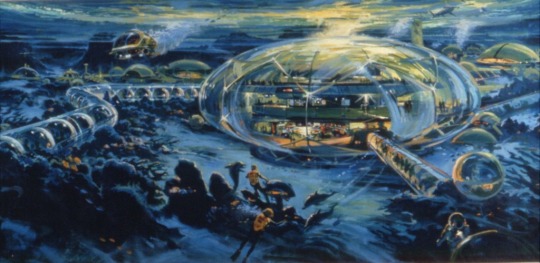
Early concept drawing (Embedded)
The original opening date for The Living Seas was sometime in 1983. In an extract from a 6 page booklet entitled “Walt Disney World EPCOT Center” the attraction was known as “THE SEAS” and it promised to take guests exploring the wonders of the aquatic frontier.
This concept promised to do this through two major presentations, the first was called “The World of the Sea” and was a ride through attraction which presented various ocean environments. Guests would've travelled in bubble-like vehicles which would’ve travelled through a series of scenes which depicted the visual drama of the ocean kelp forests, abyssal canyons and other mysterious ocean environments.
The second known as “Sea Base Alpha”. Described as, “A futuristic undersea research station with a 5,000,000 gallon tank supporting a living coral reef community,”
Two years later, revision 2 of “Walt Disney World EPCOT Center” was released, it contained 50 pages of plans and concepts including a second version of “The Seas”

A model of The Seas, the wave like design with the circular main hall (Embedded)
This version of the attraction was scheduled to open in 1984 and took a mythical perspective with the “Lord of the Seas” (Poseidon from Greek mythology). The initial plans for this version would’ve taken guests on a submarine journey in pearl-like vehicles showing surreal scenes from the environments that make up our oceans. Poseidon then challenges guests to face the oceans wisely, “With courage and determination,” disembarking into a “realistic” 21st century seabase set within a 6,000,000 gall coral reef.

A rendering of what the pavilion could’ve looked like during the Poseidon period. The dome was golden in colour, this design likely inspired the Wonders of Life (Embedded)
This design wasn’t very organic looking so in 1981 one final drawing was concieved which changed the building into a very wave like structure.

The design was changed due to cut-backs in the pavilion (Embedded).

Tim Delaney’s rendering of the front of the Living Seas, that is one heck of a sky going on there (Embedded)
The cost of the 6-million gallon aquarium turned out to be a little bit more expensive than they had originally budgeted for, so changes were made to the ride section that meant that it took more of a scientific approach to the dark ride section. However, between this final concept and the finished pavilion, the extension on the bottom of the pavilion was removed as seen from Google Maps

Tumblr doesn’t allow embeds of Google Maps, so here is a photo and a link for you
The final attraction was opened on 15th January 1986 with the final name, “The Living Seas”. The dedication was of note as Mickey Mouse and Frank Wells (the then current president of Disney) dove into the aquarium to officially open the pavilion

Just Mickey swimming in the tank with a Ray (Embedded)

(Embedded)
Guests entered the pavilion by passing a large mural that was a stylised version of a sun rising over the ocean
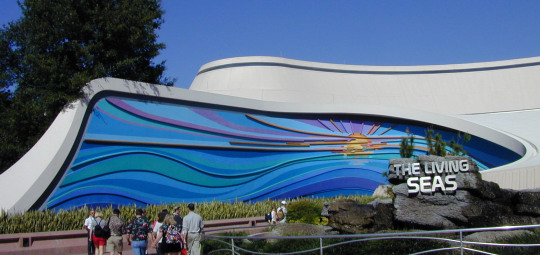
Mural by Tim J Delaney (Embedded)
Although EPCOT Center was known for having some particularly great murals, this one is certainly magnificent. The wave like structure of both the mural and the building makes this a very futuristic piece of architecture.

Pavilion logo
The pavilion opened with a large collection of images and pieces that showed ocean diving throughout history.

Guests were then put into a ‘Holding Room’ where displays showed fake adverts for United Technologies, the sponsors of the pavilion. From here, guests entered into one of the 207 seat theatre. The film was called ‘The Seas’ and was directed by Paul Gerber (Symbiosis and Norway - The Film)
youtube
After the film, guests exit the theatre to board one of three hydrolators (an underwater elevator). These took guests down to the sea bed to sea base alpha. Well I say ‘took down’, in actuality they moved only a couple of inches but was able to simulate dropping via a low frequency rumbling, visual effect and bubbles. A display panel was provided that showed guests decending through five levels of Seabase Alpha:
Surface Level
Crew Quarters
Lab Services
Observation Level
Main Level
Observation and Main level are grouped together as Visitor Center.

After exiting the hydrolators, guests boarded an omnimover a two-person “Seacab.” This took them on a short journey along the Caribbean Sea Floor. At the end of the tour, guests arrived at Seabase alpha.

A very star trek-esque designed building, with the bright colours and sharp edges. The positioning of the lights really helped to show this off.
From here, guests can learn more about the Earth’s oceans, technologies used to explore them and how guests may feel doing deep sea exploration.
A live airlock was one of the main parts of the pavilion. Presentations were conducted half-hourly where a Disney Cast member would explain the equipment used in scuba diving (wet suit and air tank), the cast member would then demonstrate this in the ‘Lock Out’ chamber. 1.5 m (5 ft) wide and 6.9 m (22.5 ft) high acrylic chamber, it took 60 seconds to fill, 42 seconds to drain and contained 4,000 u.s. gallons of water (3330 Imperial Gallons).
A manatee tank was located on the observation level and is one of the most popular areas of the pavilion, the viewing platform for the coral reef is also provided on the observation level. Occasionally dolphin demonstrations were conducted to show the intelligence of these magnificent mammals.
An interactive map of the world showed continental fault lines, volcanoes and tectonic plates. An animated ATLAS of the World was just next door, and it showed exactly that.
Guests could leave anytime via the hydrolators and then out the exit.
This pavilion was the first not to have a recognisable theme tune, instead, the pavilion had a very atmospheric area loop that is very subdued and is around 54 minutes long, about 30 of which is just ocean sea bed sound. It was also the first pavilion to have a narrative all the way through and tried to keep it as real as possible.
Over time some minor and major changes happened. In 1998 United Technologies ended their sponsorship, causing the sign on the outside to change slightly
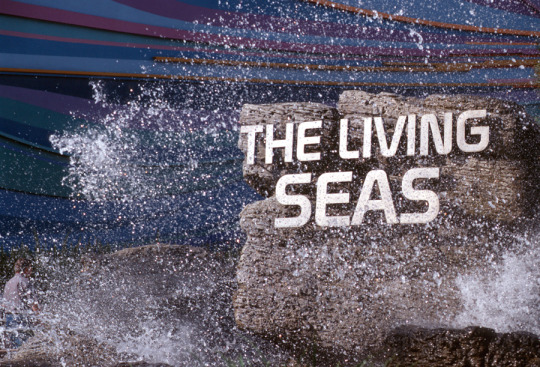
All sponsorship references were removed from inside the attraction. One of the two pre-show theatres were removed to provide a direct walkway to the hydrolators.
In October 2001 the Seacabs closed down, no reason was given however the entire walkway was left intact and the Seacabs were still visible through the tank windows. This meant guests leaving the hydrolators simply walked out and then walked along to Seabase Alpha.
In 2003, Disney started to re-theme Seabase Alpha on the then newly released Pixar film Finding Nemo. A few minor external changes were made however in January of 2004 the interior started picking up elements from the film. 16th November 2004 introduced Turtle Talk with Crush, that opened in Module 1C which was the Earth Systems exhibit. The success of this show caused the show to move to a much larger space in the pavilion.
This popularity of the show changed the course for the pavilion, for better or for worse. We’ll find out when we return later.
Next we visit
The Wonders of Life
Authors Note: I apologise for this one being late, I wasn’t happy with the previous incarnation of this and I’m still not entirely happy with this version of it. But I don’t want to leave you hanging any longer.
11 notes
·
View notes
Text
Thank you very much, yours isn't too bad either. We've just used different pictures and I haven't covered the replacements... Yet
Journey into Imagination!
The imagination, probably the most futuristic thing because without it, there is no future. So what better way to celebrate it than by taking a Journey into said imagination?

Journey into Imagination, as seen on a postcard c.1983 (Embedded)
The building for the pavilion is split essentially into three parts, the main façade, the show building (sometimes including the imageworks) and the magic eye theatre.
The design for the building itself is not entirely original, in fact the design was derived from one of the concepts for the pavilion next door, The Land with it’s crystalline structure and rising pyramids
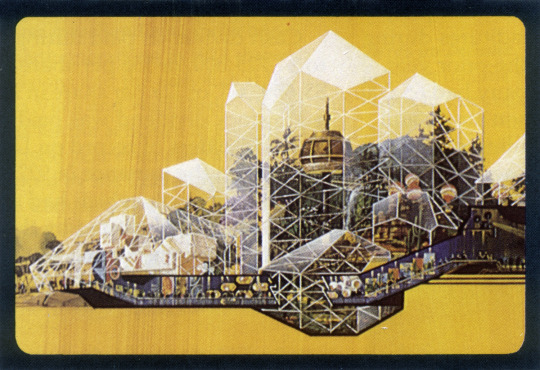
Early concept for ‘The Land’ (Embedded)
The attraction was late to open, opening on 5th March 1983 (Although the pavilion was open from day one). The reason for this is believed to have been technical issues with the ride itself as although it appeared to be an omnimover it was actually a lot more complicated than that as the cars uncoupled and went around the attraction separately from each other.

Concept art for the ride showed the guests being transported through a wide variety of strange looking landscapes that look for the most part to be nearly impossible to recreate in real life (Embedded)

Guests entered the ride right into the glass pyramids into a grand room with the typical EPCOT Center mural on the wall
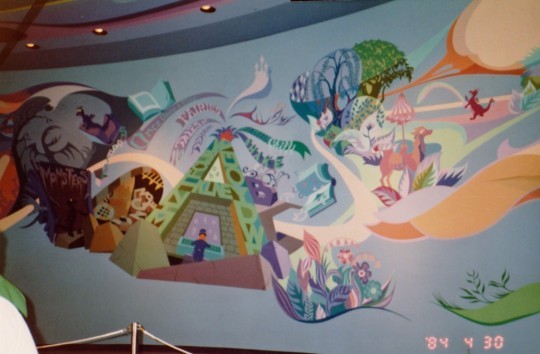
(Embedded)
From here guests boarded their “omnimover” which then proceeded into the show area where the vehicles emerge from some clouds to be greeted by the silhouette of the dream mobile and it’s pilot the Dreamfinder. Further ahead guests catch up with the dream mobile and this is where we see it and the Dream Finder for the first time.
This scene is one of the reasons why the attraction opened late, getting the vehicle, the dream mobile and the clouds all synced up with each other and the audio presented many problems for the limited computing power of 1982. One extra step was needed as well since the omnimover needed to turn to face the dream mobile . Although eventually the imagineers did get the scene to run properly it invariably didn’t run well for long, being one of the high maintenance areas of the attraction.
While here guests witness the creation of the Dreamdinders’ new comopanion, described,
“Two tiny wings, eyes big and yellow, horns of a steer, but a loveable fellow! From head to tail, he’s royal purple pigment, and there, voilà! You’ve got a Figment!”
And out of the back of the Dream Mobile popped the purple dragon

Dreamfinder at the helm with figment at the back with the idea bag (Embedded)
With the idea bag now full Dreamfinder urges the guests to follow himself and Figment back to the Dreamport which supposedly is, “Never far away when you use your imagination.”
The vehicles then return to face forward as guests are transported away to the dreamport’s storage room. In it contains a contraption designed to sort ideas as well as a few surreal items including a birdcage of musical notes and a boxed applause.
The vehicles then moved on to the art room which was a large white room with a large painting that the Dreamfinder was painting onto with a fibre optic paint brush. Figment held a pot of paint with rainbows spewing from it along with a carousel full of giant carousel animals.
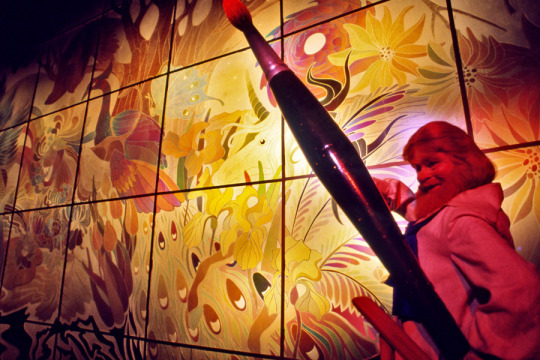
Guests then proceeded to the literature room which was themed to suspenseful stories. Dreamfinder was playing an organ which generated words from the top of it, the words eventually turned into their meanings whilst Figment tried his hardest to keep a book of horrible monsters closed
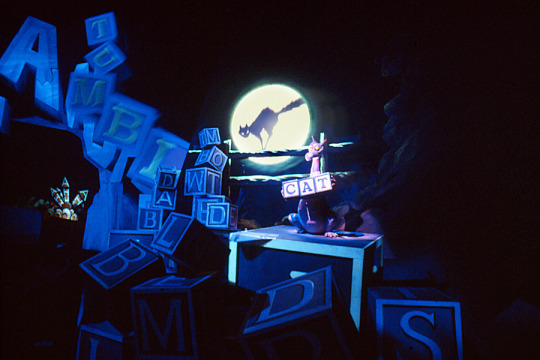
Performing arts room came next which featured Figment trying on costumes backstage whilst Dreamfinder displayed a laser light show using only his bare hands

Finally, the last room of the Dreamport was the science room which featured a rather large machine that was being operated by Dreamfinder to look at how nature worked including the growth of plants (The Land tie in) and crystal formations and the depths of space.
The ride then proceeds into it’s final show scene which was a large circular room. Upon entry the guests photo is taken as various clips of Figment doing things are projected around the room. Dreamfinder, who is riding a giant camera, then shows guests their picture and reminds them to use their sparks of imagination in the ImageWorks (which will be covered later)

Guests then proceeded to disembark and walk down possibly the greatest exit tunnel of all time (behind Horizons obviously)

So what happened next? The ride closed on 10th October 1998 for no declarable reason. Speculation however points to either the attraction becoming outdated with it’s use of technology or the cost of maintenance was way too high.
One interesting thing to note about this attraction was its use of characters, no other EPCOT Center attraction had characters as the original intention was to keep the park as free of characters as possible (look how times change). Both characters were created for the attraction, and although neither Dreamfinder nor Figment have really starred in any major productions outside of the parks, they are still recognisable characters within the Disney community.
One important thing to note is the sponsor of the pavilion, Kodak. Figment’s original concepts showed him to be a green dragon however this was changed quickly due to conflict with Kodak’s major competitors (Fujifilm) defining colour being green.

A loveable fellow
The attraction’s theme song, One Little Spark (which you can hear here in FLAC, not on Soundcloud due to copyright issues) was composed by the Sherman Brothers and performed by Chuck McCann and Billy Barty (Dreamfinder and Figment)
Of note, Dreamfinder and Figment got their own Marvel comic series called Figment. It’s not available online from the Marvel website but it costs $3.99 from the shops and looks quite interesting (< played down)
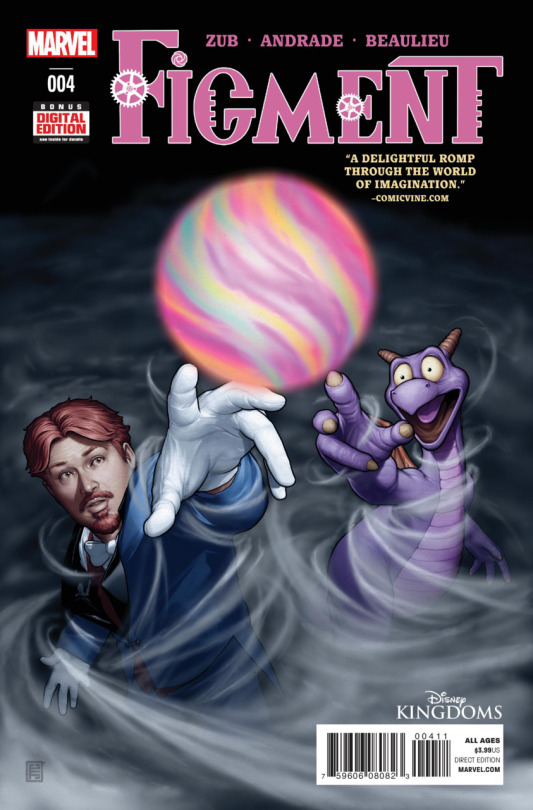
Let’s just say, someone might go bankrupt sooner or later
That’s all for the Imagination pavilion for now, we will return in the near future don’t worry.
Next, we look at the pavilion that still has ties to 1982
The Land
See you then!
79 notes
·
View notes
Text
THE LAND
The Land, we are all a part of it in one way or another. From where we place our houses to where we grow our crops, we all rely on the land all the time.

The land, as seen on a postcard in 1982
The land was the first of three pavilions in futureworld to contain more than one full attraction as well as shops and restaurants. It was designed to look like a futuristic mountain with one large central peak however this was not always the case.
Normally I leave the sponsorships to the end however for this pavilion the sponsors were very important in the designs and the attractions within the pavilion. The original plans for the land date back to 1978 when plans for Epcot Center included an Ecology and Mineral pavilion but due to how specific the theme was, this eventually fell through so the plans were widened to the planet and the environment, at this time the sponsor was a Lumber Company.

This was one of the early concepts (Embedded)
The idea was to have separate biomes (referred to as ‘Eco Zones’) held in the different sections of the crystalline structure. In this phase, the attraction also would’ve housed EPCOT Center’s first thrill ride (pictured centre) which was a drilling machine down to the centre of the Earth. Interestingly though the plan at this stage included a film about man’s connection to the planet, this film would eventually become known as Symbiosis.
This concept was scrapped when the deal between Disney and the Lumber Company fell through and the crystalline structure influenced the design of the Imagination Pavilion

(Embedded)
Kraft agreed to sponsor the pavilion in September 1978 and the theme changed once again to that of agriculture and the production of food. This design included restaurants, theatres and a boat ride that showed off different ecosystems, temporary greenhouses were placed around the back which were quickly made into permanent ones so that the boat ride could continue on through them.

This is one of the later concepts with the permanent greenhouses on the back
Inside, a wide open atrium was included to provide access to the food court and attractions. The restaurant’s windows and various walkways around the building would look down into the ecosystems of the boat ride.

The building’s footprint is just over 6-acres (Embedded)
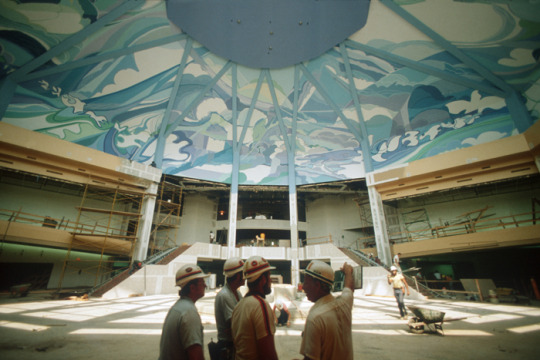
Painting and finishing off the main section of the land. Note the panels are bordered up, this was changed from early concepts which showed the glass structure to be see-through (Embedded)

The Land’s Rather green logo
Attractions
Listen to the Land
Listen to the Land was the aforementioned boat ride that opened with the park and the pavilion in 1982. The attraction opened with a stylised look at the growth of a plant, showing off the various stages of seed development. From here guests were taken through a variety of ecosystems: Rainforest, desert and the American prairie. Each of these biomes have sound and lighting effects which compliment the heat, wind and mist effects that simulate real conditions.
Here it should be noted that the original design for the boats had an opened top however because of the rainforest ecosystem the covers were added to prevent guests from getting hypothermia from the wet and the rapid changes in temperature.
Next the guests enter into a barn on the American prairie which contains images and video from farming and a super widescreen projection of footage.
Guests proceed from here to the ‘Living Laboratory’ where they can see different methods and stages of food production:
Tropics Greenhouse - Focuses on crops from tropical areas
Aquacell - Features aquaculture with a mix of high and low density tanks containing all sorts of marine life. Some of which was served at the Coral Reef Restaurant over at The Living Seas when that opened in 1986
Desert Greenhouse - Contains plants modified to grow in low-water situations
Production Greenhouse - Crops from temperate climates such as giant pumpkins and winter melons
Creative greenhouse - Future solutions to crop growth are presented here, NASA have a display here showcasing hydroponic growing which can be used in prolonged space flight
Finally, the ride concludes ride ends with a video clip showing man Listening to the Land (Which you can listen to here in FLAC goodness). This ride was guided by a live cast member, much like the Jungle Cruise but with plants instead of Tigers.
The theme song to this attraction was called ‘Living with the Land’ and it must be one of the most used song in EPCOT Center history. There were three versions played in the ride, one at the Garden Grill, one in the exterior music loop for The Land (which is still the original 1982 composition, one of the very few original pieces of EPCOT Center remaining), a small part in the old entrance medley, a nod to it in the new one and it appears in the current Innoventions area loop... and I probably still missed a few. This is simply because it is such a simple song that it can be diversified in an infinite amount of ways.
Kitchen Kabaret
Dinner that is the show! Well, it was worth a shot. When Kraft signed on as sponsor they wanted to do a show about eating healthily, but they didn’t want it to be the typical boring “Eat your greens” and so was presented as an animatronic musical/comedy review show.
The show spawned some of Epcot Center’s most recognisable songs including “Veggie Veggie Fruit Fruit (Cha cha cha)”. The show was hosted by Bonnie Appetite who is a human singing about eating her friends, who are foods... take from that what you will.
Although the show is gone, Veggie Veggie Fruit Fruit have reappeared as characters for the International Food and Wine festivals
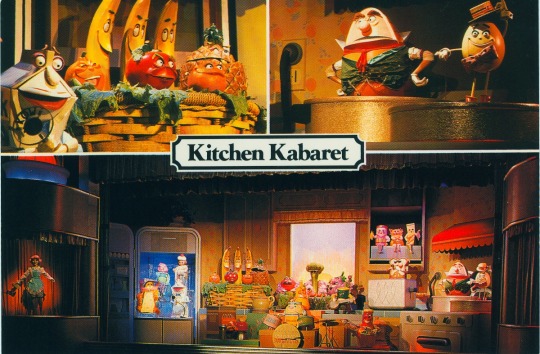
Kitchen Kabaret as seen on a postcard (Embedded)
Symbiosis
This was a film that focused on the balance between our increasing use of technologies and the environment in which we live. The film showed what humans had done to damage the environment and what we were now doing to fix the problem.
The film was shot on 70 mm film and shown in the Harvest Theatre. The director was Paul Gerber and the Narrator was Philip L. Clarke (Best known for playing Dr. Malcolm Betruger in Doom 3)
Restaurants
The land featured two restaurants, the Good Turn also referred to as in concepts as the Revolving Restaurant. This provided views into Listen to the Land and was table service

The sign out front (Embedded)
The second was the Farmer’s Market, a counter service restaurant split into 5 sections
Ice Cream
Pasta
BBQ
Potato Store
Soups/Salads
This restaurant took up the majority of the lowest floor of the main hall of The Land
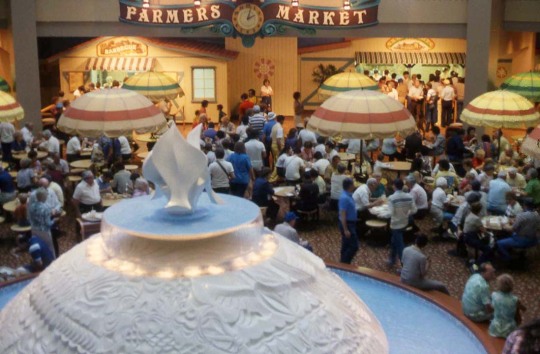
There was even a nice fountain for decoration at one point (Embedded)
Shopping
For a small period of time there was a shop called the Green Thumb Emporium that focused on food and gardening equipment. It was quickly closed because nobody goes on holiday to a theme park expecting to buy gardening equipment. Even British people don’t
The Land really was the first of it’s kind and a sign of things to come for Epcot Center. The next two pavilions to follow used a similar concept of a main hub with attractions sprawling out from behind it.
If you would like to see video of the attractions mentioned above may I point you once again to Martins Tribute to The Land
vimeo
That’s it for The Land.
Tomorrow we’re going down, deeper than we’ve been yet as we go on an undersea voyage to
The Living Seas
See you then!
33 notes
·
View notes
Text
Journey into Imagination!
The imagination, probably the most futuristic thing because without it, there is no future. So what better way to celebrate it than by taking a Journey into said imagination?

Journey into Imagination, as seen on a postcard c.1983 (Embedded)
The building for the pavilion is split essentially into three parts, the main façade, the show building (sometimes including the imageworks) and the magic eye theatre.
The design for the building itself is not entirely original, in fact the design was derived from one of the concepts for the pavilion next door, The Land with it’s crystalline structure and rising pyramids

Early concept for ‘The Land’ (Embedded)
The attraction was late to open, opening on 5th March 1983 (Although the pavilion was open from day one). The reason for this is believed to have been technical issues with the ride itself as although it appeared to be an omnimover it was actually a lot more complicated than that as the cars uncoupled and went around the attraction separately from each other.
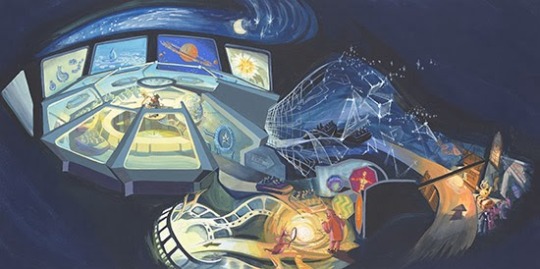
Concept art for the ride showed the guests being transported through a wide variety of strange looking landscapes that look for the most part to be nearly impossible to recreate in real life (Embedded)

Guests entered the ride right into the glass pyramids into a grand room with the typical EPCOT Center mural on the wall

(Embedded)
From here guests boarded their “omnimover” which then proceeded into the show area where the vehicles emerge from some clouds to be greeted by the silhouette of the dream mobile and it’s pilot the Dreamfinder. Further ahead guests catch up with the dream mobile and this is where we see it and the Dream Finder for the first time.
This scene is one of the reasons why the attraction opened late, getting the vehicle, the dream mobile and the clouds all synced up with each other and the audio presented many problems for the limited computing power of 1982. One extra step was needed as well since the omnimover needed to turn to face the dream mobile . Although eventually the imagineers did get the scene to run properly it invariably didn’t run well for long, being one of the high maintenance areas of the attraction.
While here guests witness the creation of the Dreamdinders’ new comopanion, described,
"Two tiny wings, eyes big and yellow, horns of a steer, but a loveable fellow! From head to tail, he's royal purple pigment, and there, voilà! You've got a Figment!"
And out of the back of the Dream Mobile popped the purple dragon

Dreamfinder at the helm with figment at the back with the idea bag (Embedded)
With the idea bag now full Dreamfinder urges the guests to follow himself and Figment back to the Dreamport which supposedly is, “Never far away when you use your imagination.”
The vehicles then return to face forward as guests are transported away to the dreamport’s storage room. In it contains a contraption designed to sort ideas as well as a few surreal items including a birdcage of musical notes and a boxed applause.
The vehicles then moved on to the art room which was a large white room with a large painting that the Dreamfinder was painting onto with a fibre optic paint brush. Figment held a pot of paint with rainbows spewing from it along with a carousel full of giant carousel animals.

Guests then proceeded to the literature room which was themed to suspenseful stories. Dreamfinder was playing an organ which generated words from the top of it, the words eventually turned into their meanings whilst Figment tried his hardest to keep a book of horrible monsters closed
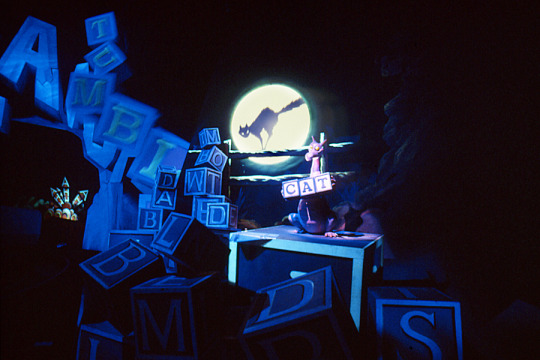
Performing arts room came next which featured Figment trying on costumes backstage whilst Dreamfinder displayed a laser light show using only his bare hands

Finally, the last room of the Dreamport was the science room which featured a rather large machine that was being operated by Dreamfinder to look at how nature worked including the growth of plants (The Land tie in) and crystal formations and the depths of space.
The ride then proceeds into it’s final show scene which was a large circular room. Upon entry the guests photo is taken as various clips of Figment doing things are projected around the room. Dreamfinder, who is riding a giant camera, then shows guests their picture and reminds them to use their sparks of imagination in the ImageWorks (which will be covered later)
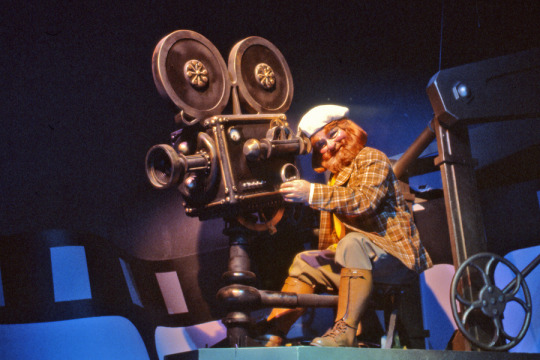
Guests then proceeded to disembark and walk down possibly the greatest exit tunnel of all time (behind Horizons obviously)

So what happened next? The ride closed on 10th October 1998 for no declarable reason. Speculation however points to either the attraction becoming outdated with it’s use of technology or the cost of maintenance was way too high.
One interesting thing to note about this attraction was its use of characters, no other EPCOT Center attraction had characters as the original intention was to keep the park as free of characters as possible (look how times change). Both characters were created for the attraction, and although neither Dreamfinder nor Figment have really starred in any major productions outside of the parks, they are still recognisable characters within the Disney community.
One important thing to note is the sponsor of the pavilion, Kodak. Figment’s original concepts showed him to be a green dragon however this was changed quickly due to conflict with Kodak’s major competitors (Fujifilm) defining colour being green.

A loveable fellow
The attraction’s theme song, One Little Spark (which you can hear here in FLAC, not on Soundcloud due to copyright issues) was composed by the Sherman Brothers and performed by Chuck McCann and Billy Barty (Dreamfinder and Figment)
Of note, Dreamfinder and Figment got their own Marvel comic series called Figment. It’s not available online from the Marvel website but it costs $3.99 from the shops and looks quite interesting (< played down)

Let’s just say, someone might go bankrupt sooner or later
That’s all for the Imagination pavilion for now, we will return in the near future don’t worry.
Next, we look at the pavilion that still has ties to 1982
The Land
See you then!
79 notes
·
View notes
Link
Yesterday we looked at Horizons, and today the Disney Parks Blog posted a quiz online about horizons. Why not give it a go? (I got 12 out of 16, and they probably weren’t the ones you expected me to get wrong)
1 note
·
View note
Text
World of Motion
The world of motion, EPCOT Center’s very own comedic look back at transportation throughout the ages. Opening along with the rest of EPCOT Center, guests could travel back in time in order to look into the future at transportation from the invention of the wheel to a metropolis in perpetual motion

The was designed by animator Ward Kimball who added his own humorous look back at to what was otherwise a fairly serious park. The construction of the pavilion was part of the initial plans for EPCOT Center
There it is at the back of the eastern half of future world (Embedded). This Concept Model was in Disney News (Spring 1979) available to Magic Kindom club members. Although the design was slightly different, it still incorporated the circular design but over time the design simplified and became the simple wheel seen on construction completion.
One of the original titles for the attraction was “Transcenter” and the even tackier “Transcenter 2000″ before finally settling on “The World of Motion”. One thing to note is that Disney claim that one of its first names was simply “The Transportation Pavilion”, but this is the name of the building rather than the name of the attraction inside. The name “TransCenter” was eventually used for the post-show.

The logo of The World of Motion
The ride had a rather unique opening for an omnimover as guests boarded their vehicles, climbed a slight slope and then left the building temporarily to join the story on the second floor of the building

The opening in the middle of the ride as seen on a postcard in 1982
Our host for the ride was Gary Owens a radio presenter and voice actor best known for voicing Space Ghost (in the original show) as well as Roger Ramjet.
The first scene was a look at cavemen and the first means of transportation and one of the most common: footpower. From here we moved to a scene showcasing early sea-travelling techniques such as a raft. Next we move along to see one of the first animal powered forms of transport showing an Assyrian person trying to control a variety of animals.
Guests then move on to Babylon and the invention of the wheel with three pitches for what the wheel should be, a triangle, a square and the best of show, the circle!

(Embedded)
Riders then pass through a “wheel factory” which for some reason included a Trojan Horse. Guests then reach the age of flight where they see Leonardo da Vinci hard at work trying to get the design right for some sort of flying contraption, his devotion to these machines upsets what appears to be Mona Lisa. Then for some bazaar reason we see a hot air balloon over the roof tops of London with a man and a wide selection of animals inside.
“Nothing stands in the way of progress” our narrator says as a steam trains’ journey is brought to a halt by a bull on the line, along with the authentic steam locomotive the scene also presents an “authentic train robbery”.
Guests are then brought to the world’s first traffic jam, which looked a little like this (Embedded):

Horses get spooked easily so we of course move onto the natural progression of horseless carriages with cars throughout the early 40′s and 50′s. The next section of the ride is a speed tunnel, like the one seen in the attractions: If you had wings, Delta Dream flight and Buzz Lightyear Space Ranger Spin (All occupying the same space in Tomorrowland at the Magic Kingdom)
The speed tunnels includes images of crop dusting (I had to google what that was), white water rafting and snowmobiles. The end of the tunnels bring us to CenterCore, the perpetual city of the future, full of ever moving vehicles.

(Embedded)
Finally, just before unloading guests are shown themselves in “The car of the future” using the semi-transparent mirror technique as seen in the hitchhiking ghosts in the Haunted Mansion

TransCenter (Embedded)
The post show to World of Motion was the TransCenter, an exhibition space for transportation. This space included mini-attractions such as “The Lean Machine” and a show called “The Bird and the Robot” which had as its stars a Toucan and assembly line robot called Tiger in a show that educated guests about the importance of the General Motors assembly line.
Concept 2000 showed how GM makes concepts and prototypes of cars which may be featured at some point in the future
vimeo
The attraction as a whole was sponsored as part of a 10-year deal with GM whose contract ended in 1992. From then on, due to the decline in the car market, GM sponsored the attraction one year at a time before eventually deciding to ask for a new attraction based solely on cars to help promote their brands.
When GM executives rode the World of Motion for the last time on the 2nd January 1996 it broke down, forcing them to walk back to the exit.
The theme song of the World of Motion was written by X Atencio (famous for Writing Yo Ho! A Pirates life for me and Grim Grinning Ghosts) and Buddy Baker (known for scoring The Fox and the Hound) and was called It’s fun to be free. Which you can listen to here in all it’s FLAC high quality goodness!
That’s all for the World of Motion, we’re finished with Future World East for now, we’ll circle back round later to cover Wonders of Life, Mission: Space and Test Track.
Tomorrow won’t you join me for
Journey into Imagination
See you then
17 notes
·
View notes
Audio
Fancy some New Horizons in FLAC (i.e. the highest quality?) Then listen to it here!
What’s your favourite EPCOT theme song?
6 notes
·
View notes
Text
HORIZONS

Horizons as seen in 1983
This attraction started life back in 1979 as a pitch by the show’s designer, George McGinnis, initially as ‘Century 3′ which was chosen as the name since the United States had just entered it’s 3rd Century of existence. The ‘Century 3′ name was dropped quickly since the name would've been lost on most guests who were not in the know. It’s second name, which stuck for a while, was ‘Futureprobe’. This name was eventually changed due to the un-intentional medical nature of the name since a future probe could be medical equipment from the future which could've confused some guests. Finally the name ‘Horizons’ was settled on as a reference to looking towards the future.
The budget for the ride was originally $70 million however due to the initial over spending on the Epcot Center project, the budget had to be cut back by $10 million which reduced the size of the building and removed 180 m (600 ft) of track from the ride. Something else cut from the ride due to technical issues was the effect of the vehicles seen throughout the ride morphing from one form to another, simply because the technology did not exist, but it explains why the three mini vehicles seen in the attraction look similar.
The building was huge covering 3,400 m2 (37,000 sq ft ) and used in excess of 3,400 tonnes (3,700 tons) of steel which is more than Spaceship Earth which is practically made of steel. The final track length was 410 m (1,346 ft) and it held 184 vehicles in a sideways omnimover fashion. Each vehicle could hold 3 - 4 guests for a maximum capacity between 552 and 736 guests. The vehicles moved at 0.47 m/s (1.53 ft/s) which made the ride last around 15 minutes
youtube
Video showing some of the ride in it’s construction phases
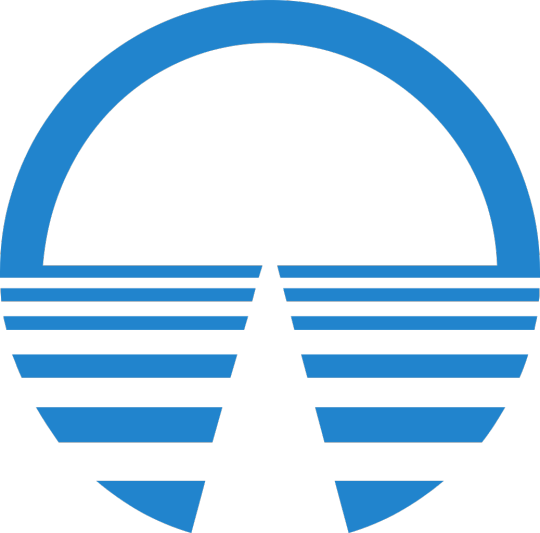
The Horizons Logo
A theme song was also important, there are 6 demo versions that have surfaced over the years of a song called “Reach for New Horizons” each sharing lyrics and a name but with different genres of music. All 6 have different styles and genres whilst sharing lyrics and 5 of these 6 can be found in this one handy video (the sixth can be found in Martin’s Tribute):
youtube
However towards the end of development of the attraction this version was scrapped in favour of a different song simply called New Horizons which features a continuity throughout the attraction. You can listen to it in all it’s high quality flac-ness here.

Horizons, presumably early in it’s life due to the absence of over grown trees and Wonders of Life (which I didn't forget about, I'm coming back to it)
The ride opened on 1st October 1983, one year after Epcot Center opened to much fanfare.
Through the entrance was the ‘future port’ an air port for the future

A couple of the destinations were in Spanish, presumably that is the dominant language in the future (like Esperanto is in Red Dwarf)
The departure board showed that horizons was boarding for departure, that was the journey that guests would be taken on regardless of where they actually wanted to go or not. From here to boarding, guests would have the opportunity to see adverts for the other destinations, adverts included concept art from the rides development to narration telling guests more about the destinations and travel arrangements.
Upon boarding the ride vehicle the doors would close and give the announcement:
“Horizons 1 is now departing. Our final destination today, the 21st Century”
Which was a bold statement.
The theme of Horizons was future study’s, and to try and accurately depict the future based on pre-existing information so in order to tell guests that this ride is 100% concept they were treated to some predictions of era’s gone by from Jules Verne right through to the 50′s using a mix of scenes and movie clips

This fantasy actually came semi-true, thanks to the roomba
From here guests were treated to not one, but two omnimax screens showing images of then modern technologies and concepts that could be used in the future. And omnimax screen (just incase you are wondering) is a 180° screen onto which an IMAX film (with a fisheye effect) is projected onto. However, in Horizons case, instead of utilising the whole screen, a small portion of the screen was used and tracked ride vehicles so film appears to move in sync with the ride vehicles. To give you an idea of how large one of these screens was here is a cross section of the building:
The screen spanned 2 whole floors, and can be viewed in it’s full glory here
From here guests were invited (without a choice) to see what the future was really like in the 21st century. The first scene showed off the family’s house in the city, complete with holographic skype, strange instruments and some of the strangest buildings you could ever imagine outside the window.

Guests would then continue into the desert to see how agricultural changes have made growing crops in harsh conditions possible, this was something that Disney and Nasa were working on over at ‘The Land’ at the time (and still are to this day) which meant that this wasn’t just 21st century stuff, this was on the horizon.

Mesa Verde (Which translates to Green Table, national qualification in Spanish came in handy here)
Next we went under the sea to the Sea Castle, a whole city that functions under the water. Here we see a school underwater teaching children how to swim and explore underwater, followed by undersea research and even a restaurant.

Next guests made a bit of a jump to Brava Centauri and to the most memorable part of Horizons, the space scene. The first piece of music set the tone for this section, listen to it here and see what I mean.
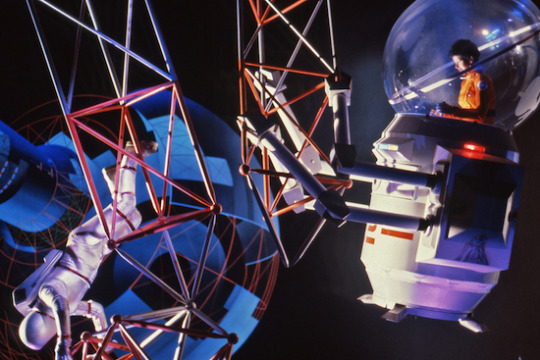
This section of the ride showed people living, working and having fun in space. It really captured the excitement that one day we could all be living and working in space (despite the physical implications of this).

Here is a family getting used to living in space
From here our hosts leave us to go and wish happy birthday to their grandson, a scene that cost $3,000 just for the royalty’s alone. The scene featured giant holograms done through peppers ghost which showed members of the family (including our hosts) celebrating the child’s birthday

Now, the exiting part and the second omnimax part of the ride, where guests were invited to choose their own way back to the futureport via one of three ways. Mesa Verde, Sea Castle or Brave Centauri, of course, majority rules. A 31 second film would then play showing the desired ending for each individual car. The films were filmed on scale models (some of the largest ever created at the time) which were filmed frame-by-frame on computer controlled camera rigs. Some were filmed twice to create different effects such as and undersea mist and dust clouds.
The models were built in a hangar at Burbank Airport. It took over a year to build and shoot the three segments.
A full model of the desert scene (as featured on kesigndesign and embedded from that website)
The ride concluded with the GE logo (sponsors at the time) and the guests disembarking. The exit corridor originally featured a mural called The Prologue and the Promise by Robert T. McCall who was best known for creating some of the best futuristic paintings ever (nasa even hired him)
View this in full res (you’ll be glad you did)
vimeo
Martin’s Ultimate Tribute, showcasing the ride in its entirety
So then, what happened next?
30th September 1993 GE dropped sponsorship causing the ride to go down to remove all references (including script changes)
In December 1994 Horizons Closes indefinitely due to structural concerns of the building, the roof had started to give way in places
December 1995 and the attraction re-opened to deal with capacity issues as most of Future World East was closed
31st December 1998 and the internal publication called Eyes and Ears announced that Horizons would close for the final time on 9th January 1999, all signs were removed by 23rd September 1999
Horizons opens for press groups on 30th September 1999 and that would be it’s last time opening.
Demolition began on 7th July 2000 and was completed 10th September 2000 (I will go more in depth on this when I do Mission: Space later this month)
It was a pretty brutal demolition, taking no care at all of the building itself (embedded from here)
But why did it close? A few factors, least of which was the rides attendance which dwindled shortly after opening, the lack of renovations since the ride in 1999 was exactly how it was in 1983 with no major renovations taking places at all, components were wearing down and sets were falling apart. The ride became very dated, very quickly since technology moved forward far quicker than predicted since we now have a space colony (ISS), desert irregation and life at sea (although no holograms yet) and for an attraction that mocks the 50′s for it’s predictions, that isn’t a good thing. The main reason for closing was the sink hole that the attraction was built on, causing structural problems with the pavilion building, not aided by the fact it was bloody heavy and literally pulling itself apart. Keeping it there would’ve closed the attraction sooner or later anyway.
But Horizons lives on, not only in memory but also in references dotted all over the place. Disneyland in California had some of the robots featured in the mural
Space Mountain in Disney World has bags destined for Mesa Verde, as well as a few post-show scenes inspired by Horizons
Walt Disney: One Man’s Dream contains some props from the ride including the robot butler as seen above
In Tokyo Disneyland’s Start Tours, all three of the ending films can be seen on a kiosk at the exit. Each film is played in full and is branded as a Star Tours excursion (This is something needed in the Florida version although guests in Tokyo may not be aware of Horizons so this footage means nothing to them)
On top of this several celebratory pins have been released like this one:
Part of a series (Embedded)
And again the Disney Parks blog keeps reminding us of the attraction (in fact, some of the photos in this post have come from there)
13 Reasons Disney Parks Fans Still Love Horizons Today and A Look Back at Horizons at Walt Disney World Resort are both good
That’s all for today, thank you for reading through this. Tomorrow we’ll be looking at The World of Motion. We’ll circle back round and do Mission: Space and the Wonders of Life later in the month because I wan’t to get originals out of the way first
A quick shout out to @figmentjedi for having probably the best avatar I’ve ever seen as well as to @its-fun-to-be-free for sharing some of WDW’s history with us all and finally to @one-magic-spark for the memorabilia from the past (and the likes, re-blogs and follows, hint hint)
If you have something you want to share with me, please don’t hesitate to send it this way via the submit page. I’m always on the lookout for anything and everything EPCOT related
Again, thank you for reading and I’ll see you tomorrow for
World of Motion
Bye now!
dailymotion
24 notes
·
View notes
Photo
Tomorrow we cover Horizons, but until then here are some pictures to wet your appetite




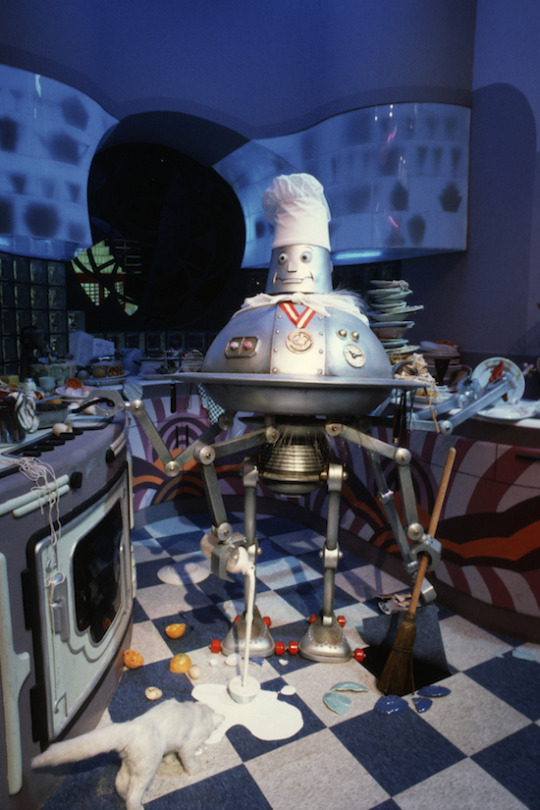




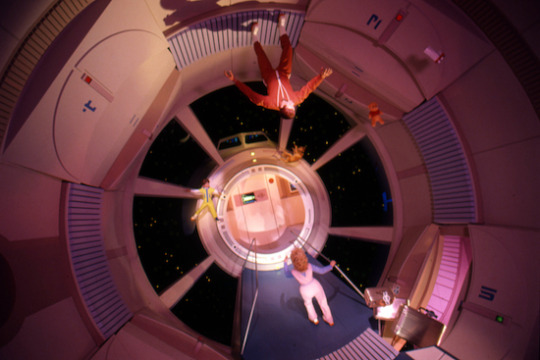
Remembering Epcot’s Horizons which opened 32 years ago on October 1, 1983.
(via 13 Reasons Disney Parks Fans Still Love Horizons Today « Disney Parks Blog)
521 notes
·
View notes
Text
Universe of Energy

Universe of Energy, as seen on a postcard in 1982
The building of the energy pavilion is unlike many others as indeed is the ride itself. The building is a huge affair with a sloping design falling towards you and covers an area of around 2 acres. Along the sides were coloured blocks ranging from red to yellow presumably to represent the different stages of fire. The roof is covered with 2,200 solar panels on top (80,000 3-inch photovoltaic cells) which is used to power the ride vehicles inside the attraction but we’ll circle back round to that in a bit

Original ride logo (which can now be seen on a mosaic in the entrance)
The original show is split into 5 segments. The first is the pre-show which takes place in the entrance hall of the building and is one of the most interesting pre-shows of all time, it was an 8 minute film called “Kinetic Mosaic” and used a system of 100 motorised panels that swivelled and turned to create depth in the film (although the screen did not work until 1984 due to some mechanical problems). This technique was invented by the Czech director Emil Radok and proved troublesome for the parks technicians who were constantly servicing the 100 prism screen.
youtube
The pre-show featuring the Radok screens
Although the screens were impressive, the show itself was your typical landscape videography narrated by Vic Perrin and featured one of the two main theme songs of the attraction, Energy (You make the World go Round) which you can listen to in all it’s flac goodness here.
After the pre-show had finished the doors beneath the screens opened to reveal a large room. Inside the room were 6 ride vehicles, each able to seat around 80 guests. At the start of this section all 6 of the ride vehicles are together as they rotate in unison 180° to face the doors that the guests just came through, a second film then played showing how life began on earth and the formation of fossil fuels.
Here is a theatre (embedded)
From here the seating rotated again to face a curtain which lifted to show a primeval diorama, here the vehicles split up and became semi-autonomous (as they were free to move but tried to stay as close to a copper wire embedded in the ground) as they travelled through the diorama depicting many dinosaur-like scenes. The diorama is around 160 m (515 ft) and took artists 6000 hours to paint the background for it.
As the vehicles left the diorama they converged again inside the EPCOT Energy Information Center where a 12 minute live action film played on 3 giant wrap around screens. This film looked at how we used energy today and how we might use energy in the future (including future resources)
Towards the end of the film the vehicles make their way back into the first theatre where guests had boarded the vehicles, inside theatre one was a two minute computer animated film including vector graphics that also reflected off mirrored walls within the theatre. This film was accompanied by the second of the two theme songs for this attraction simply titled “Universe of Energy” which I can be listened to here in FLAC (not on soundcloud though due to copyright reasons)
The show lasted around 45 minutes, could contain around 500 guests and had 34 Audio-animatronics of all sizes. Between shows, the ride vehicles would sit on charging pads which draw power from the roof’s solar panels
vimeo
Here is Martins Tribute which provides some full POV ride on action
On January 1st 1996 the original version closed for refurbisment, but not for long as in June of that year it re-opened to help with the summer crowds (due to most of future world East being closed). It showed the original films from Universe of Energy as the new ones weren't finished yet, albeit with a few changes. The radok screens disappeared which made the opening film just that little bit worse, the dinosaurs in the diorama had been repainted to show the current understanding of dinosaurs skin tones (Note that the new AA’s had been installed of Ellen DeGeneres and Bill Nye but rocks were placed in front as not to confuse guests, although some dinosaurs had been re-programmed which meant they attacked rocks), the EPCOT Energy Information Center was gone being replaced by a radio tower which was for the new show (which meant a revised script had to be written to remove all references to the EEIC), the final scene had removed the mirrored walls which made it seem a bit lifeless in comparison.
The pavilion closes again on 1st September 1996 to install the new film and re-opened as Ellen’s Energy Crisis on 15th September. The name didn’t stick and very quickly became Ellen’s Energy Adventure because it sounds better.
The new attraction opened to much fanfare with Bill Nye and Jamie Lee Curtis (Stupid Judy) attended the re-dedication of the attraction. Ellen was not present. Additionally, the exterior was re-painted to be more dynamic
The exterior now has rainbowed edged (Embedded)
Besides film changes and new animatronics the show wasn't too different but instead featured Ellen DeGeneres on her quest with Bill Nye the Science Guy to find a new energy resource. It focuses on the origins of fossil fuels and how we may need to start looking toward renewable sources.
The ride vehicles are now entirely autonomous, they essentially do their own thing but are programmed to be at certain points at certain times and are aware of their surroundings, the copper wire from the original incarnation is still there.
youtube
Here is a nice ride-through for you (ignore the panels, I’m about to talk about them)
In 2004 the sponsor ExxonMobil drops out leaving the pavilion without a sponsor for the first time in 22 years. In 2008 the ride goes down for a lengthy refurbishment to update some of the AA’s, some of the computer systems and restore the original colour scheme to the outside of the building
Here we can see the new scheme being painted on (Embedded)
And that’s it for the Universe of Energy.
Tomorrow we continue clockwise with:
Horizons
See you tomorrow
youtube
#Epcot Center#EPCOT History Month#Epcot#universe of energy#ellen's energy adventure#BILL NYE THE SCIENCE GUY
20 notes
·
View notes
